Guillaume Chansarel, an artist about town
Parisian artist Guillaume Chansarel belongs to that increasingly rare breed of city dwellers: the happy ones. You will never hear him complaining about the big city pollution, traffic and stress: to him happiness is urban chaos! Like Tokyo: « Over there, they have about 10 motorways right in the centre of town, up above your head, meandering through the city skyline! » he enthuses. What to others would be a nightmare to Guillaume Chansarel is an endless source of astonishment and inspiration. His urban landscapes, painted onto pages of text from antique books, from Hong Kong to New York, convey the flavour of the place and the mood of that moment. How can the artist be so spot on with his subject? Because he knows, better than most, how to become one with his environment, completely acclimatize himself to each of the cities he visits. This is what he has just achieved with his most recent project: Drawing Avenue* - to cover the 22 kms of Broadway in 7 days stopping to sketch at every intersection!
This project has inspired a limited edition art book that Guillaume Chansarel will sign this coming Thursday (6 Dec 2018) from 18h30 - 21h at Lardanchet bookstore (100, rue du Fbg St Honoré Paris 8).
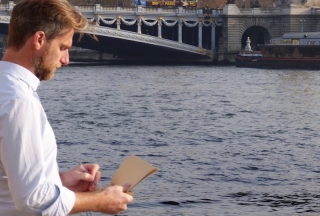
Why this exclusive interest for the major cities?
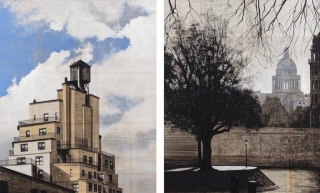
I am at my best, feel full of life, the true me in a big city! The more a city is insanely huge and modern the more I am like a fish in water. Architecture seems to be my natural territory. I love it! Being in a city like Tokyo and sensing all the frenzy. Over there it is teeming every which way, under ground, rushing on the pavements, even over head!
What qualities do you look for in an urban landscape?
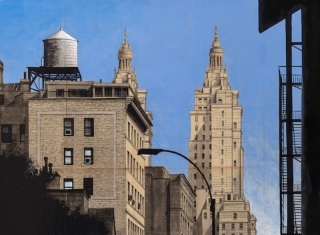
An urban landscape is an endless subject for inspiration. To glorify a building there is obviously the framing, the light but there is above all the surprise. You cary on in a certain perspective and then, bam! A particular architecture appears. A door, an arch, a shop window, a sky-scraper, whatever else? You take this same street the other way and you realize that it is this very architecture that makes the perspective so powerful. And you can go inside a building and completely alter your perception of the town. And who knows what you'd discover climbing onto the roof? A major city is a creativity machine
As an artist how do you go about capturing a new city?
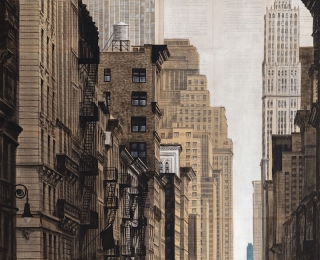
When I am discovering a new city I try and remain as neutral as possible. A quick look at the general layout: the airport's over there, my hotel is here, that's it! I need to be like an explorer setting off to discover the new world.
In this relationship to the city, are there other artists who have particularly influenced you?
Difficult not to be influenced by Hopper as he captured, perhaps better than anybody, the soul of a city. A window in New York or a bridge in Paris, you're there. It's crazy! I could also obviously mention Marquet, Szafran or even Caillebotte, especially for his famous "Paris, temps de pluie", from the construction of the drawing right down to the wet cobble stones. For hours I have stood before this painting in Chicago. There are also Berenice Abbott's photos, historical shots, Paul Faure or Christophe Jacrot today… and then, very recently, Cédric Klapisch captured New York like no-one else in his film "Casse-tête chinois."
How do you work?
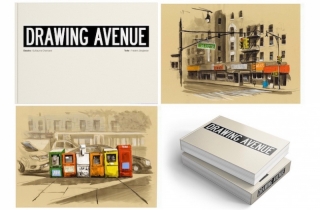
My work method is comprised of several stages: first the drawing. Always. Be just a quick note or a more involved sketch, I draw the subject, the idea being to possess it. Next, depending on the material I shall use for the painting I might finish off with some photos. I will photograph a building or a construction for technical details. Materials, ornamentation… I have also filmed if I feel it might be necessary to revisit the atmosphere.
When I produce my drawings on large canvasses I use a grid system so as to respect the perspective. My aim is to recreate the image as accurately as possible. China ink and acrylic are my preferred techniques.
You paint on pages of antique books that you collect during your travels. What made you think of this support?
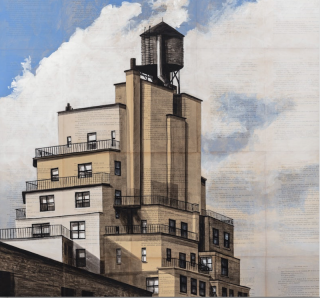
I have always had travelogues, life-logues, and I love changing around the support. One day nearly 20 years ago, at an antique book fair, I came across a book from 1856 with yellowed paper and a sheen. I bought it and drew directly onto the print. Once inked and colored these sketches took on a relief and an astonishing, unexpected aspect. Very soon after, I cut the pages out to stick onto larger formats, and this technique has been evolving ever since.
Today, above and beyond the technical aspect, I have taken this method to a completely different level: as the world is signaling the end of publication, I am giving it a whole new life!
Is there a connection between the painting's subject and the underlying text?
The theme of the book on which I paint is barely important. What I find interesting is bringing together drawing and writing on the same support. Two means of graphic communication invented by man.
You were trained as a scenographer. Are your compositions like sets where the viewers will be able to project their own stories?
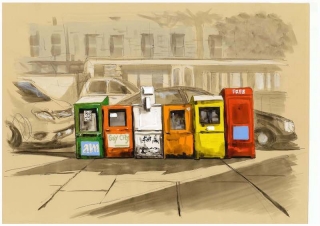
That is the little added extra that you get in front of certain paintings. Someone once told me at an exhibition that they had hung one of my paintings in front of their bed. A perspective of train tracks with a series of metal bridges - and every night he heard the shunting on the rails as he turned out the bedside light. That gives me untold pleasure! But what I am really looking for from my painting is to catch the eye. That the emotion be sudden and immediate.
What is your most recent project?
My last project is a true confession of love for New York… that is Manhattan to be precise. I walked the entire 22 kilometer length of the legendary Broadway Avenue from north to south. Sketchbook in hand, at each intersection I'd stop to do a sketch on the spot: architecture, fire escapes, urban furnishings, yellow cabs, trucks…whatever passed before my eyes. In all, I did 247 drawings. The first from the bridge joining the Bronx and Manhattan, the last from the Staten Island ferry. And to be in perfect harmony with "the city that never sleeps", I did all this in just 7 days.
Why did you produce a book about it?
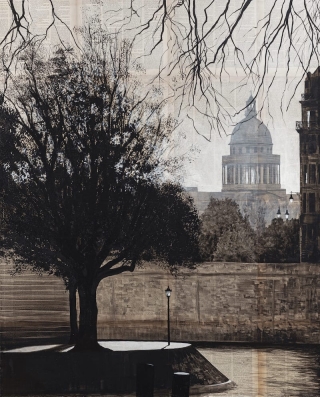
New York, is life, noise, metal, droning, sirens, shouts, emergency flashing lights… it's impossible to convey all that in one drawing. Added to which I wanted to be able to relive, and most of all, share my experience. You turn the pages just as I progressed down that avenue from block to block… Bit by bit the sky-scrapers appear on the horizon. This book is a ginormous tracking shot through the city.
What to you is the definition of luxury?
For me it's the ability to create. What gives me direction, what moves me, is creativity. To constantly have, not just the desire, but the opportunity to create. Luxury for me is not about obtaining the unobtainable, luxury is accomplishing what you set out to do.
A luxury that you couldn't do without?
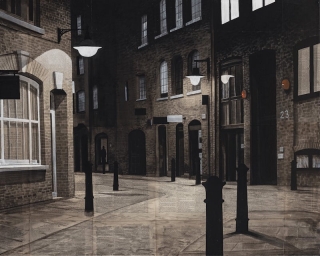
Go to New York on the spur of the moment and once there, decide to create a book:-)

Why this exclusive interest for the major cities?
I am at my best, feel full of life, the true me in a big city! The more a city is insanely huge and modern the more I am like a fish in water. Architecture seems to be my natural territory. I love it! Being in a city like Tokyo and sensing all the frenzy. Over there it is teeming every which way, under ground, rushing on the pavements, even over head!
What qualities do you look for in an urban landscape?
An urban landscape is an endless subject for inspiration. To glorify a building there is obviously the framing, the light but there is above all the surprise. You cary on in a certain perspective and then, bam! A particular architecture appears. A door, an arch, a shop window, a sky-scraper, whatever else? You take this same street the other way and you realize that it is this very architecture that makes the perspective so powerful. And you can go inside a building and completely alter your perception of the town. And who knows what you'd discover climbing onto the roof? A major city is a creativity machine
As an artist how do you go about capturing a new city?
When I am discovering a new city I try and remain as neutral as possible. A quick look at the general layout: the airport's over there, my hotel is here, that's it! I need to be like an explorer setting off to discover the new world.
In this relationship to the city, are there other artists who have particularly influenced you?
Difficult not to be influenced by Hopper as he captured, perhaps better than anybody, the soul of a city. A window in New York or a bridge in Paris, you're there. It's crazy! I could also obviously mention Marquet, Szafran or even Caillebotte, especially for his famous "Paris, temps de pluie", from the construction of the drawing right down to the wet cobble stones. For hours I have stood before this painting in Chicago. There are also Berenice Abbott's photos, historical shots, Paul Faure or Christophe Jacrot today… and then, very recently, Cédric Klapisch captured New York like no-one else in his film "Casse-tête chinois."
How do you work?
My work method is comprised of several stages: first the drawing. Always. Be just a quick note or a more involved sketch, I draw the subject, the idea being to possess it. Next, depending on the material I shall use for the painting I might finish off with some photos. I will photograph a building or a construction for technical details. Materials, ornamentation… I have also filmed if I feel it might be necessary to revisit the atmosphere.
When I produce my drawings on large canvasses I use a grid system so as to respect the perspective. My aim is to recreate the image as accurately as possible. China ink and acrylic are my preferred techniques.
You paint on pages of antique books that you collect during your travels. What made you think of this support?
I have always had travelogues, life-logues, and I love changing around the support. One day nearly 20 years ago, at an antique book fair, I came across a book from 1856 with yellowed paper and a sheen. I bought it and drew directly onto the print. Once inked and colored these sketches took on a relief and an astonishing, unexpected aspect. Very soon after, I cut the pages out to stick onto larger formats, and this technique has been evolving ever since.
Today, above and beyond the technical aspect, I have taken this method to a completely different level: as the world is signaling the end of publication, I am giving it a whole new life!
Is there a connection between the painting's subject and the underlying text?
The theme of the book on which I paint is barely important. What I find interesting is bringing together drawing and writing on the same support. Two means of graphic communication invented by man.
You were trained as a scenographer. Are your compositions like sets where the viewers will be able to project their own stories?
That is the little added extra that you get in front of certain paintings. Someone once told me at an exhibition that they had hung one of my paintings in front of their bed. A perspective of train tracks with a series of metal bridges - and every night he heard the shunting on the rails as he turned out the bedside light. That gives me untold pleasure! But what I am really looking for from my painting is to catch the eye. That the emotion be sudden and immediate.
What is your most recent project?
My last project is a true confession of love for New York… that is Manhattan to be precise. I walked the entire 22 kilometer length of the legendary Broadway Avenue from north to south. Sketchbook in hand, at each intersection I'd stop to do a sketch on the spot: architecture, fire escapes, urban furnishings, yellow cabs, trucks…whatever passed before my eyes. In all, I did 247 drawings. The first from the bridge joining the Bronx and Manhattan, the last from the Staten Island ferry. And to be in perfect harmony with "the city that never sleeps", I did all this in just 7 days.
Why did you produce a book about it?
New York, is life, noise, metal, droning, sirens, shouts, emergency flashing lights… it's impossible to convey all that in one drawing. Added to which I wanted to be able to relive, and most of all, share my experience. You turn the pages just as I progressed down that avenue from block to block… Bit by bit the sky-scrapers appear on the horizon. This book is a ginormous tracking shot through the city.
What to you is the definition of luxury?
For me it's the ability to create. What gives me direction, what moves me, is creativity. To constantly have, not just the desire, but the opportunity to create. Luxury for me is not about obtaining the unobtainable, luxury is accomplishing what you set out to do.
A luxury that you couldn't do without?
Go to New York on the spur of the moment and once there, decide to create a book:-)
Décembre 2018




